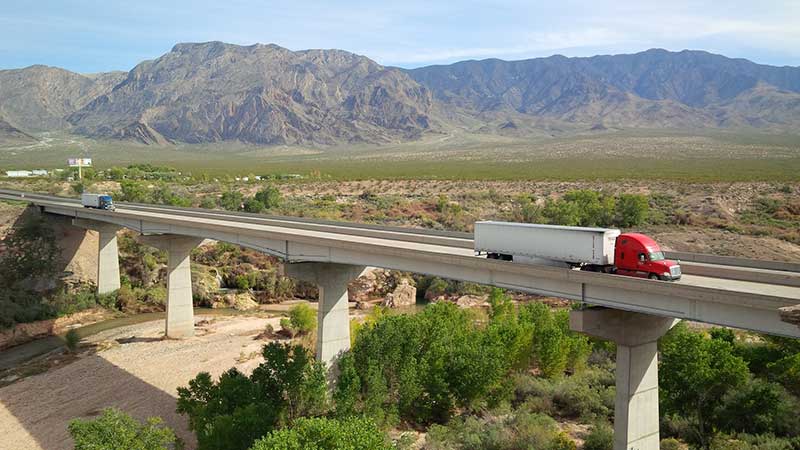Trailblazers tested in building highway through remote gorge
Trailblazers tested in building highway through remote gorge

It is a remote highway carved through a steep canyon in northwestern Arizona a half century ago.
The project to build 29 miles of Interstate 15 across a corner of the state through the Virgin River Gorge was one of the most challenging and costly road projects in its day. The stretch opened in 1973 after a decade of construction.
The Arizona Highway Department, now ADOT, spent more than $48 million, or about $1.63 million per mile, for the four-lane interstate and seven bridges.
Max Blazzard, Highway Department chief project supervisor, got a close look at the roadless Virgin River Gorge when he moved his family to St. George, Utah.
"Some of the roughest terrain is in the lower one and a half miles of the lower gorge,” Blazzard said. “It doesn’t look too difficult from 14,000 feet in the air, but when you get a closer look, it’s hard to visualize a divided highway in this area. The canyon is so narrow and deep the sun never hits in some sections during the winter months."
Long retired construction workers said ice clogged the river in winter. Summer temperatures soared to near 120 degrees, and monsoon-storm flows threatened workers and construction workers in the river bottom. The men told of scaling 100-foot cliffs, blasting away sheer walls of stone and bulldozer operators navigating on dangerous slopes.
A trade publication, Western Construction, reported that a contractor’s helicopter crashed in the gorge. The pilot and passenger survived, but the helicopter disappeared into quicksand.
The remarkable engineering feat, overcoming many obstacles to build the highway, was documented in the 2014 film "My Father’s Highway" by Dixie State College filmmakers.
Kent Goodman, 84, of Henderson, Nevada, also wrote a short history of the lower gorge project. He still marvels at the courage and tenacity of the construction team.
Goodman was equipment superintendent for Peter Kiewit Sons’ Co., which was paid $13.85 million to build the roadbed and five bridges for the final 3.8 miles of the highway from 1969-71.
Kiewit started its I-15 work east of Littlefield by "pioneering a rough access road through the gorge" that crossed the Virgin River 18 times, Goodman said.
"It was the most challenging road project Kiewit ever had," he said.
The Arizona Highway Department should be “congratulated on the fine, and many times dangerous, work they performed in calculating and then laying out survey information on the rock face” using rock climbers, Goodman said.
Blazzard said the Highway Department used a “marsh buggy” with 5-foot tires to cross the river.
Kiewit brought in 140 pieces of earth-moving equipment, including 20 D8 Caterpillar bulldozers, 25 rock trucks with a 50-ton capacity and a truck crane with a 60-ton capacity.
Workers relied on 45 pickups to move around the job site. The brakes had to be replaced every six weeks because the trucks were driven across the river so often. Goodman said they quickly learned to mount two-way radios on the underside of the roofs after several trucks were flooded during deep-water crossings.
Some of the cuts on the steep canyon walls started 300 feet above the river. Workers carried jackhammers and 50-pound bags of blasting powder up the slopes.
Goodman recalled bulldozer operator Jock Carnes operating on a ridge 100 feet above the canyon floor when an anchoring sling broke.
"The D7 (Caterpillar) went skidding down the near vertical rock face with Jock riding the brakes just enough to make sure the dozer blade was staying downhill … it rolled out in the sand and gravel until Jock could stop it."
Goodman said Carnes took a short break while workers rigged a new tie-off sling and “then he started winching himself back up the slope as though nothing had happened.”
Workers were also at risk of flash flooding in the Virgin River Gorge. A 10-foot wall of water surging down the canyon was not uncommon, Blazzard said.
Kiewit had a metal barrel anchored upstream, and if it floated to a high-water mark it would trip a switch. Foremen in the lower gorge were notified by telephone that they had as little as 90 minutes to get the men and equipment to high ground before floodwater surged through the gorge.
"It was a crude system, but it worked," Goodman said.
Building I-15 opened an important route connecting California, Nevada and Utah, but it was far less important for Arizona since the highway only cut across a dog-eared corner of the Arizona Strip north of Grand Canyon.
Before Arizona completed the interstate through the gorge, travelers had to detour on US 91 north from Littlefield with slow-moving trucks grinding up Utah Hill.
"This detour on Route 91 was quite scenic, but the two-lane road made for some real challenges, sort of like an E-ticket ride at Disneyland," Goodman said.
"The saving grace for having to travel over Utah Hill was when you reached Santa Clara (Utah) you could stop at one of the fruit stands and buy a cool, white peach that was about the size of a grapefruit."
Finally, after close to a decade of construction, I-15 was completed in late 1973. Arizona Gov. Jack Williams and Utah Gov. Calvin Rampton (pictured right with their wives, Lucybeth Rampton and Vera May Williams) dedicated the highway on Dec. 14, 1973. The new route cut 11 miles off the trip and traversed a scenic gorge that draws comparisons to the Grand Canyon.
"Somehow, here in the far northwest corner of Arizona, man’s efforts have enhanced rather than distracted from Nature’s handiwork," wrote JaNice Ott in an August 1988 article in Arizona Highways. She noted that bighorn sheep can be spotted on cliffs overlooking the highway.
Today, more than 24,000 vehicles per day travel through the Virgin River Gorge. Over the past few years, ADOT has completed major rehabilitation projects on the seven bridges and repaved the entire 29-mile stretch of I-15 in Arizona.


